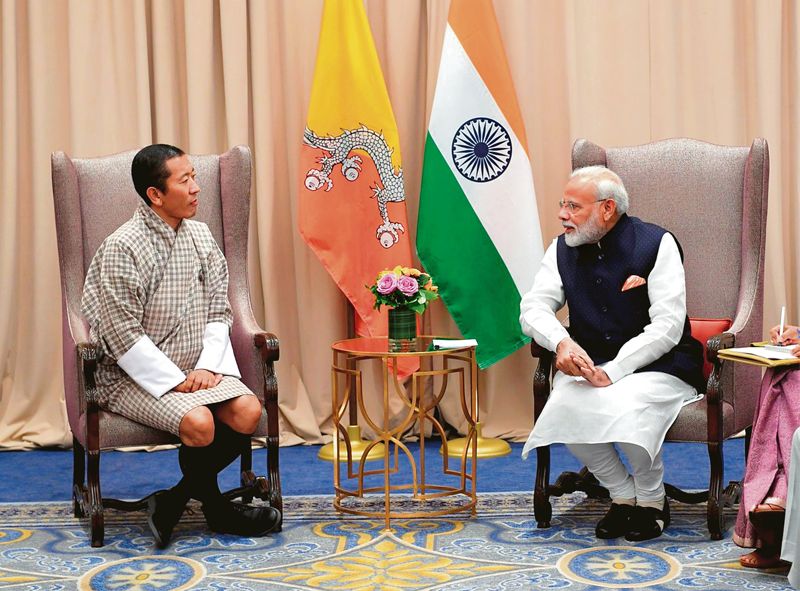
SHIFTING SANDS: PM Narendra Modi with his Bhutanese counterpart Lotay Tshering. PTI
Anand Kumar
Associate Fellow, Manohar Parrikar Institute for Defence Studies & Analyses
CHINA and Bhutan recently signed a memorandum of understanding (MoU) to resolve their long-standing border dispute. This development was important as Bhutan is generally seen as a close ally of India. This has also raised an important question whether Bhutan was being coerced by China. The security of India and Bhutan is also closely linked. The way Bhutan sorts out its border issues with China is going to have implications for Indian security. It will also have its bearing on the bilateral relationships these countries are having with one another. The signing of the MoU takes place amidst a 17-month-long standoff between India and China in Ladakh, even as Indian efforts to defuse the situation have not been successful.
Since June 2020, China has also been persistently making claim over the Sakteng Wildlife Sanctuary in eastern Bhutan. This is seen as an attempt by China to put additional pressure on Bhutan to come to the negotiating table. China is quite keen to establish diplomatic relationship with Bhutan. This is one country in South Asia where it has not been able to make major inroads.
Bhutan and China started their talks in 1984 to resolve the border dispute. Since then, 24 rounds of talks have taken place, but there has been no major progress. To break the deadlock, China has now signed this MoU and hopes to resolve the dispute on its own terms. This MoU talks about a three-step roadmap, but so far no details have emerged. Some Chinese experts, however, believe that the roadmap might be similar to the principles of the China-India border talks. They will first establish basic political principles of boundary demarcation, and then solve specific disputes. They will finally sign an agreement and get down to the boundary demarcation.
The Chinese, however, are also apprehensive that they may not succeed in their designs as Bhutan’s ceding of its disputed territory in the western part to China in exchange for Chinese claim on some territory in its northern part will have implications for India’s security. It thinks that India will try to scuttle the final agreement when it is reached.
In the past year, there has been a change in the Chinese style of diplomacy. Now the tone of China’s foreign ministry against the US, Australia and other countries has become much more strident. The Chinese diplomacy is no longer conservative, passive and low key, but has become assertive, proactive and high profile. Chinese diplomats try to defend the ever-expanding national interests, often in confrontational ways.
This change in Chinese diplomacy started since 2010 when China’s GDP overtook Japan’s as the world’s second largest. This has made China a nation much more confident and its foreign policy far more assertive. The ‘wolf-warrior diplomacy’ is also seen as a manifestation of the rising nationalism in China.
Besides combative words, diplomacy has also resulted in aggressive actions. China has bullied Vietnam and on April 19 last year, it named 80 islands, reefs, seamounts, shoals and ridges in the South China Sea, triggering protests from other claimants.
China is also indulging in various grey zone operations. These are those operations where the Chinese do not clearly violate international law but put pressure on the adversary and test its resolve to defend its claims. This has happened in the case of India, where the Chinese have frequently violated the disputed international border. This has also happened in the case of Japan and Taiwan. Recently, the Taiwan tensions flared up to such an extent that the country declared it might go to war if the Chinese encroachments of their air space continue. It also forced the United States to come out openly in support of Taiwan in case a war breaks out.
The Chinese are also trying to bully Bhutan. In 2017, they were carrying out illegal infrastructure activity in the Doklam region when India was forced to come to the assistance of the Bhutanese. This led to a major standoff. Though the tension was defused later, it is believed that China is still trying to consolidate its position in the area. Since then, China has also started blaming India for intervening in its territorial dispute with Bhutan and calls India’s military assistance to Bhutan an infringement of its sovereignty.
Bhutan is one of India’s strongest allies, but the bilateral relationship has been undergoing a perceptible change. Both countries re-negotiated their 1949 treaty and entered into a new treaty of friendship in 2007. The new treaty has replaced the provision which required Bhutan to take India’s guidance on foreign policy. Now, Bhutan also does not require India’s permission to import arms. Moreover, Bhutan has also seen a transition to multi-party democracy. This change in the polity of Bhutan has brought important changes in its foreign and economic policies. Bhutan wants to become a high income country by 2030. Initially, India was the only development partner of Bhutan, but the Himalayan nation now has 52 more such partners. China intends to become its 53rd development partner after establishing diplomatic relationship with the country.
Bhutan still wants to make its economic progress largely with the help of India. At the same time, it does not want the India-China rivalry to create problems for it. As Bhutan can’t meet the growing military assertion of China on its border, it has signed the present MoU with the hope to buy temporary peace. India, however, has to be careful as the boundary claims of China have been ever-expanding in the region and no one knows what the Chinese would claim next as part of south Tibet.
Join Whatsapp Channel of The Tribune for latest updates.




























